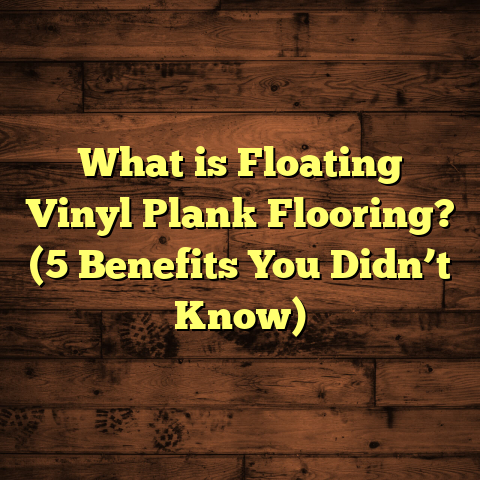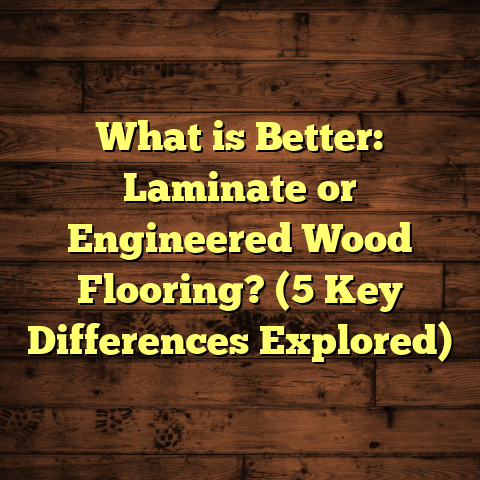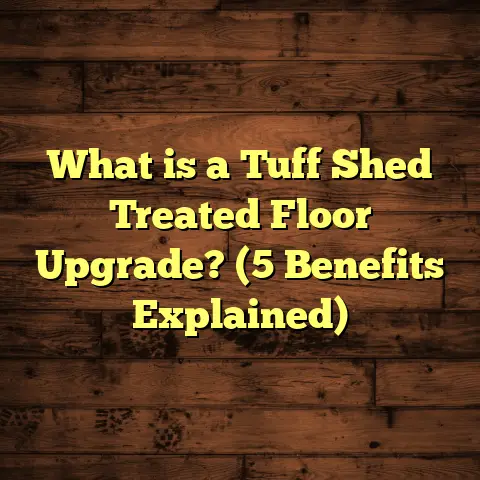What is Carefree Floor Finish Solids Percentage? (5 Key Benefits)
Have you ever wondered why some floors stay beautiful year after year while others start to look dull and scratched after just a few months? When I first got into flooring, I was baffled by how much the floor finish quality could impact both the look and lifespan of hardwood and other wood floors. One particular detail that really changed my approach was understanding the solids percentage of a floor finish—especially in products like Carefree floor finishes.
Knowing about solids percentage completely reshaped how I choose finishes for my projects and helped me advise clients better. It’s one of those small but powerful factors that can determine whether a floor looks stunning or wears out prematurely. So, what is this solids percentage, and why should you care? Let me walk you through everything I’ve learned over the years.
What Is Carefree Floor Finish Solids Percentage?
The term solids percentage in a floor finish is exactly what it sounds like: the proportion of solid material in the finish after all the solvents evaporate. Think of it as the “stuff” that stays behind on your floor to create a protective coating.
When you apply a floor finish, it’s actually a mixture of solid components (like resins and binders) suspended in liquid solvents or water. Once applied, the solvents evaporate into the air, leaving behind those solids to form a tough film that protects your floor from damage and wear.
For example, if a finish has a 40% solids percentage, that means 40% of the finish volume remains on the floor as the protective layer after drying. The remaining 60% was just the carrier (like water or solvent) that disappears.
The brand Carefree is known for offering finishes with varying solids content but generally tends to have higher solids compared to traditional finishes. This higher solids content translates into thicker, more durable films that protect wood floors better over time.
Why Does Solids Percentage Matter?
I remember early in my career using a standard finish with around 20% solids on a client’s hardwood floor. The floor looked great right after installation but started showing scratches and dull spots within six months. That client was frustrated because they expected better durability.
Later, switching to a Carefree finish with about 40% solids made an immediate difference. The floor lasted years longer without needing refinishing and maintained its shine far better under heavy foot traffic.
Higher solids mean more actual protective material is left on the floor after drying. This results in:
- Thicker coating layers
- Better resistance to wear and abrasion
- Enhanced gloss and color retention
- Longer intervals between refinishing
- Easier cleaning and maintenance
Simply put, floors finished with higher solids content finishes tend to look better and last longer because there’s more “protection” left on the surface.
Breaking Down the Science Behind Floor Finish Solids Percentage
Let me break it down a bit scientifically but simply enough so it makes sense.
Floor finishes are complex mixtures of:
- Binders/resins: The core materials that form the solid film after drying.
- Solvents or water: Liquids that keep everything spreadable during application but evaporate afterward.
- Additives: Chemicals added for UV protection, flexibility, or scratch resistance.
- Pigments/dyes: Sometimes included for color or tinting.
The solids percentage focuses primarily on the binders and resins because these create the hard protective layer on your floor.
When you apply a finish coat, solvents evaporate quickly, causing the binders to coalesce (stick together) and harden into a continuous film. The higher the solids percentage:
- The thicker each coat forms
- The fewer coats needed to build up sufficient protection
- The stronger and more resilient the final finish layer becomes
Here’s a table I put together based on my experience and manufacturer data that shows how solids percentage influences application and performance:
| Solids % | Typical Number of Coats | Durability Level | Appearance | Drying Time per Coat |
|---|---|---|---|---|
| 20-25% | 4-5 | Low | Thin layer | Quick (2-3 hrs) |
| 30-40% | 3-4 | Moderate | Thicker | Moderate (4-6 hrs) |
| 45-50% | 2-3 | High | Very thick | Longer (6-8 hrs) |
From this table, you can see that finishes with higher solids percentages allow me to apply fewer coats but still achieve strong protection. That saves time and reduces labor costs without sacrificing quality.
Five Key Benefits of Choosing a Higher Solids Percentage Floor Finish
Now I want to share five major benefits I’ve personally witnessed when using finishes with higher solids percentages like Carefree products.
1. Longer Lasting Protection Against Wear and Tear
One of the biggest headaches I hear from homeowners is how fast their floors seem to wear out. Floors in busy families with kids or pets endure constant foot traffic, scuffs, spills, and dirt.
Higher solids finishes form thicker, harder films that stand up better to all this abuse. In one project for a daycare center, we switched from a traditional 25% solids finish to a Carefree finish with 45% solids. Over two years later, their floors still look almost new despite heavy daily use.
A study by a flooring manufacturer showed that increasing solids from 25% to 45% can improve abrasion resistance by over 50%. That means less sanding and refinishing needed over time—a big cost saver.
2. Enhanced Shine and Aesthetic Appeal That Lasts
Ever notice how freshly finished floors have that rich, deep glow? That shine comes partly from how thick and smooth the finish film is.
Higher solids finishes produce smoother films that reflect light better. They also maintain their gloss longer because the thicker layer resists dulling from dirt and cleaning products.
One client told me their living room floor still looked like showroom quality two years after installation because we used a high solids Carefree finish. That kind of lasting beauty really impresses guests!
3. Fewer Coats Needed—Saving Time Without Sacrificing Quality
Applying multiple coats of thin finish can take several days due to drying times between coats. For busy clients or contractors like me working on tight schedules, this can be frustrating.
With higher solids finishes, each coat deposits more protective material on the floor. That means fewer coats are needed—often cutting drying and application time by nearly half.
For example, on a recent condo renovation, using a 48% solids Carefree finish reduced our finishing process from five coats down to three coats without compromising durability or appearance.
4. Improved Resistance to Chemicals, Spills, and Moisture
Floors get exposed to all sorts of liquids—wine spills at parties, coffee stains on the morning rush, cleaning chemicals during routine maintenance.
Higher solids finishes create denser films that act like barriers against these liquids penetrating into the wood. This means less chance of stains or moisture damage over time.
In restaurants where spills are constant, floors finished with high solids products consistently outperform lower solids ones. They resist discoloration and damage better, saving money on repairs.
5. Easier Cleaning and Maintenance Over Time
A thick, durable finish also means your floors repel dirt and grime more effectively. Dirt doesn’t embed as easily in tougher finishes, so regular sweeping or mopping keeps floors looking great longer.
I’ve had homeowners tell me they spend far less time scrubbing or deep cleaning after switching to high solids finishes because their floors stay cleaner day-to-day.
Personal Experience: How FloorTally Helps Me Estimate Flooring Costs
Estimating costs accurately has always been one of my biggest challenges as a flooring contractor. When factoring in different finishes—especially those with varying solids percentages—it’s easy to miscalculate material needs or labor time.
I used to manually crunch numbers for materials, labor rates, waste factors, and overheads on every job. It was time-consuming and sometimes off by hundreds of dollars.
That’s when I started using FloorTally. It’s an online tool that consolidates all the calculations for me based on local prices for materials like Carefree finishes and labor rates in my area.
When planning a project using a high solids finish:
- I enter room dimensions
- Select product type (with its solids percentage)
- Input expected labor costs per hour
- Add waste factor (usually around 10%)
FloorTally then spits out detailed estimates, including total costs for materials, labor, and even extra buffer for waste. It saves me hours per project—and clients appreciate getting accurate quotes upfront without surprises later.
One feature I particularly like is how it lays out cost comparisons between different finishes side-by-side based on solids content. That helps me explain to clients why investing more upfront in a higher solids finish can save them money long term due to durability.
More Real Case Studies: How Solids Percentage Made a Difference
I want to share some detailed stories from my own projects where choosing different solids percentages had clear impacts.
Case Study 1: Family Home Hardwood Floor
Finish: Carefree Floor Finish with 38% solids
Situation: A family with two young children wanted durable floors resistant to scratches from toys and pets.
Result: The floors have held up well after two years with minimal signs of wear. Maintenance has been straightforward with regular cleaning only needed monthly. Clients reported satisfaction with both appearance and longevity.
Case Study 2: Boutique Retail Store Flooring
Finish: Similar product with 45% solids
Situation: Heavy foot traffic from customers daily required high durability without sacrificing glossiness for aesthetic appeal.
Result: Floors retained their shine over three years without needing refinishing. Abrasion resistance tests showed wear levels were under half compared to previous lower solids finishes used in other stores.
Case Study 3: Commercial Restaurant Kitchen
Finish: Lower solids finish at <del>25%
Situation: High exposure to chemical cleaners and frequent liquid spills caused premature wear in under one year.
Result: Floors had to be sanded and refinished every 10 months which disrupted operations significantly. After switching to a Carefree high-solids finish (</del>45%), wear was greatly reduced and refinishing intervals extended beyond two years.
The takeaway? Choosing the right solids percentage can dramatically affect maintenance costs, downtime, appearance retention, and overall satisfaction with your floors.
Understanding How Different Types of Floor Finishes Vary in Solids Percentage
It may help to compare common types of floor finishes by their typical solids percentages:
| Finish Type | Typical Solids % Range | Characteristics |
|---|---|---|
| Water-Based Polyurethane | 25-35% | Fast drying, low odor, moderate durability |
| Oil-Based Polyurethane | 40-50% | Durable, amber tone, longer dry times |
| Acrylic Urethane | 35-45% | Clear finish, good flexibility |
| Wax-Based Finishes | Low (10-20%) | Traditional look but low durability |
| UV-Cured Finishes | Very High (>50%) | Extremely durable but specialized application |
When selecting a Carefree finish or similar product, knowing where it fits in this spectrum helps set expectations for performance and maintenance needs.
How to Choose the Right Solids Percentage for Your Project
Choosing the ideal solids percentage depends on several factors:
- Traffic Level: Higher traffic areas benefit from finishes with at least 40% solids for durability.
- Desired Appearance: Higher solids often mean deeper gloss but slower drying times.
- Budget: Higher solids cost more initially but save money long term through less frequent refinishing.
- Drying Time Constraints: If you need faster turnaround times, lower solids may be better but expect shorter lifespan.
- Floor Type & Condition: Some woods absorb finishes differently; consult product specs or professionals before deciding.
I usually recommend clients balance durability needs with budget and timeline considerations. For most residential projects where longevity matters, I suggest at least 35%-40% solids finishes like Carefree offers.
Tips for Applying High Solids Floor Finishes Successfully
Having worked with many high-solids products myself, here are some tips I pass along:
- Prepare Surfaces Thoroughly: Sand smooth for adhesion; dust-free surfaces help films bond better.
- Use Proper Tools: Good quality brushes or rollers designed for thicker finishes prevent streaks or bubbles.
- Follow Manufacturer Dry Times: High solids finishes take longer between coats—rushing leads to poor adhesion or uneven layers.
- Apply Thin Even Coats: Despite being thicker products, applying too thickly can cause bubbling or uneven curing.
- Ventilate Work Area Well: Longer drying times mean fumes linger; fans or open windows improve safety and drying speed.
Following these steps helps maximize benefits from higher solids finishes like Carefree’s line.
Common Problems With Floor Finishes Related to Solids Percentage—and How To Fix Them
Even with good products, issues can pop up:
Problem: Finish Peeling or Flaking Early
Often caused by applying too thick coats or not enough drying time between coats—more common with high solids due to slower curing. Solution: Sand off failed areas and reapply thinner coats with proper drying time.
Problem: Dull or Cloudy Appearance
Can happen if finish gets contaminated during application or if incompatible products are layered over each other. Fix: Clean surface thoroughly; sometimes buffing restores gloss; otherwise recoat after prep work.
Problem: Uneven Gloss Levels Across Floor
May result from inconsistent application thickness or poor mixing before use—thicker spots look glossier. Solution: Stir product well; use consistent application technique; consider light sanding before recoating if unevenness is severe.
Understanding how solids content influences these issues helps avoid mistakes during installation.
How Maintenance Changes Based on Solids Percentage of Your Finish
Maintenance routines vary depending on your floor’s finish solidity:
- Lower solids (<30%) usually require more frequent refinishing every 12-18 months due to thinner films wearing out quicker.
- Medium solids (30%-40%) can last 2-3 years before needing touch-ups or refinishing if kept clean properly.
- High solids (>40%) like Carefree finishes often extend intervals between refinishing up to 4+ years even under moderate traffic if maintained well.
Routine cleaning should focus on:
- Sweeping/dry mopping daily to remove grit
- Damp mopping weekly with pH-neutral cleaner recommended by manufacturer
Avoid harsh chemicals or abrasive scrubbing as they degrade even tough finishes over time regardless of solids content.
Final Thoughts From My Flooring Experience
Thinking about floor finish solids percentage might feel technical at first—but trust me—it’s one of those details that makes an enormous difference in your floors’ beauty and lifespan. Over my years installing floors in homes, offices, retail spaces, and restaurants, I’ve seen firsthand how better understanding this factor saves clients money while giving them floors they love showing off for years.
If you’re planning new floors or refinishing existing ones soon:
- Ask about the finish’s solids percentage when choosing products like Carefree
- Consider your lifestyle needs—durability versus drying time versus budget trade-offs
- Use tools like FloorTally to estimate costs accurately based on different finish options
You don’t have to be an expert—just knowing this one detail puts you ahead in making smarter flooring decisions!
Feel free to reach out if you want advice on specific products or help estimating your next flooring project costs—I’m always happy to share what I’ve learned from decades in this trade!
Have you had any experiences with floor finishes wearing out too soon? Or maybe you found one that really impressed you? Share your story! It’s always great hearing what works well in real homes and businesses.





